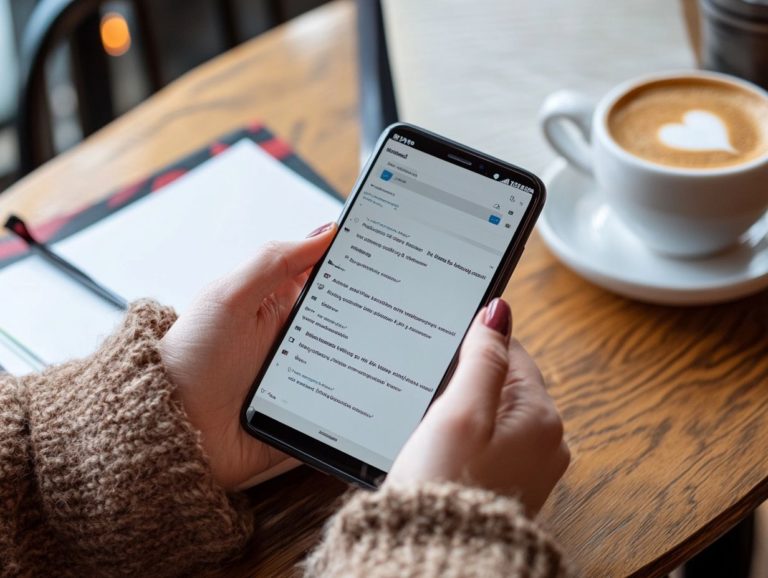How to Re-Engage Inactive Subscribers
Let's Set Up Your Lead Generation Strategy
Fill out the form below, and our team will get in touch with you to create a tailored solution for your business.
In today s digital landscape, maintaining subscriber engagement stands as a cornerstone for any brand’s success, particularly in the realm of email marketing. You may find yourself facing a segment of your audience that has gone quiet. Wondering why your subscribers have gone silent? To navigate this challenge, it s essential to understand the reasons behind subscriber inactivity and implement effective re-engagement campaigns that can breathe new life into your communication efforts.
Let s dive into how to turn those dormant subscribers into active participants again! This article provides actionable strategies for re-engagement and best practices for measuring success. Explore the insights within to discover how to turn the tide and rekindle your relationship with those dormant subscribers.
Contents
- Key Takeaways:
- Understanding Inactive Subscribers
- Re-Engagement Strategies
- Let's Set Up Your Lead Generation Strategy
- Best Practices for Re-Engaging Subscribers
- Let's Set Up Your Lead Generation Strategy
- Measuring Success and Adjusting Strategies
- Let's Set Up Your Lead Generation Strategy
- Frequently Asked Questions
- Let's Set Up Your Lead Generation Strategy
Key Takeaways:

- Understand why subscribers become inactive to effectively target and re-engage them.
- Segment your subscriber list and use personalized messaging to regain their interest.
- Offer incentives and promotions to encourage inactive subscribers to become active again.
Understanding Inactive Subscribers
Why is it important to understand inactive subscribers? They play a key role in your email marketing success. These individuals may have engaged with your content in the past, but now they ve slipped into dormancy.
It s important to recognize the reasons behind this decline in engagement. This understanding allows you to craft effective re-engagement strategies that enhance subscriber preferences. Inactive subscribers represent a valuable segment of your email list that can be brought back through targeted initiatives.
By focusing on this group, you can enhance customer interaction and elevate your overall engagement strategies. Ultimately, this generates high-quality leads through personalized emails.
Defining Inactivity
What does inactivity in email marketing mean? It usually refers to identifying subscribers who haven t interacted with your emails over a set period. This signals a potential decline in engagement, and you can measure this lack of interaction through various metrics like open rates, click-through rates, and response rates.
These metrics reveal how many subscribers are reading or clicking through. They re also vital indicators of your email s overall effectiveness. For example, if your open rates dip below 15%, it might be time to reassess your strategy.
Take a look at a case study involving a prominent e-commerce brand like Amazon Prime. After noticing that many subscribers hadn t engaged in over six months, they launched a re-engagement campaign to drive customer acquisition. By providing personalized content and enticing incentives, they managed to revive nearly 30% of their inactive subscribers.
Ignoring inactivity can waste resources and harm your sender reputation, which ultimately impacts future campaigns and your return on investment.
Why Subscribers Become Inactive
Subscribers can drift into inactivity for several reasons. Shifts in consumer behavior, a scarcity of relevant content, or the absence of personalized experiences that align with their preferences can all contribute. Recognizing these factors is essential for organizations aiming to reconnect with dormant customers and enhance their email marketing strategies.
When consumer priorities shift, engagement can wane. Individuals may find previous content less appealing or useful. Employing strategies like marketing automation tools allows you to craft tailored content that resonates with different audience segments, improving your engagement strategies.
By analyzing subscriber interactions and preferences, you can create a more personalized approach that reignites interest. Implementing a series of automated emails sent over time, sending re-engagement emails, and offering exclusive incentives like discount codes can rekindle motivation among your subscribers. This fosters a deeper connection and encourages consistent interaction.
Re-Engagement Strategies
Re-engagement strategies are crucial for revitalizing your inactive email list. They aim to transform dormant customers into active subscribers through personalized communication and targeted emails. By leveraging tailored emails and targeted messages, you can enhance your lead generation through effective marketing strategies and improve customer acquisition efforts. This ultimately fosters stronger connections with your audience.
Segmenting Your Subscriber List

Let's Set Up Your Lead Generation Strategy
Fill out the form below, and our team will get in touch with you to create a tailored solution for your business.
Segmenting your subscriber list is essential for developing impactful engagement campaigns. This strategy enables you to tailor your messaging based on the unique preferences and behaviors of your subscribers, enhancing subscriber engagement.
With tools that help you send emails automatically, you can customize content for various segments, ensuring your emails resonate with each distinct audience. This method not only boosts open rates but also elevates overall customer satisfaction by delivering pertinent information.
Effective email segmentation strategies can include:
- Targeting based on age, gender, or location
- Behavioral segmentation based on previous interactions
- Interest-based grouping
By using marketing automation systems, you can analyze data with remarkable efficiency. This uncovers specific patterns that reveal your audience’s needs and preferences. For example, consider sending tailored promotions to your frequent buyers, while crafting different messages for new subscribers. This targeted approach can significantly enhance engagement and drive conversions, ultimately leading to improved retention rates and loyalty among your subscribers.
Personalization and Targeted Messaging
The key to your effective re-engagement strategy lies in delivering a personalized experience through targeted emails that resonate with your audience. This enhances brand loyalty. By honing in on engagement tactics that prioritize customer interaction, you can cultivate meaningful connections with your subscribers, encouraging them to re-engage.
To achieve this, leveraging data analytics is essential. By analyzing past interactions, preferences, and purchasing behaviors, you can segment your audience more effectively.
Tailoring your messages based on these insights allows for a more relevant approach, whether you’re promoting a new product or offering a special discount. Incorporating dynamic content that adapts to individual subscriber preferences enhances the appeal of your emails and drives higher engagement rates.
This thoughtful personalization not only strengthens relationships but also rekindles interest among recipients, transforming passive subscribers into enthusiastic participants in your online events.
Offering Incentives and Promotions
Offering incentives and promotions, like exclusive offers or discounts, is an exciting way to rekindle interest in your brand among inactive subscribers. By integrating these retargeting campaigns into your email marketing strategy, you can spark renewed engagement and potentially cultivate high-quality leads.
When you tailor incentives to the preferences of dormant customers, such as exclusive offers and loyalty points, you’re crafting a personalized experience that resonates with your audience. Consider options like loyalty points, act fast! Limited-time offers that you can’t miss!, or even enticing free shipping these can serve as compelling motivators to draw them back in.
Take, for example, a well-known e-commerce site that recently launched a campaign offering a 20% discount exclusively to customers who hadn t made a purchase in over three months. The result? An impressive 40% boost in engagement rates.
Integrating birthday discounts into your emails or offering free shipping has proven to be particularly effective. It not only celebrates the customer but also gives them a delightful reason to return and treat themselves on their special day.
Best Practices for Re-Engaging Subscribers
Implementing best practices for re-engaging your subscribers is essential. This helps maintain a robust email marketing strategy that captures valuable feedback. Optimizing the timing and frequency of your communications to align with what your subscribers expect is key.
Crafting compelling content that grabs attention can greatly enhance your engagement strategies and foster meaningful interactions.
In summary, utilizing effective re-engagement strategies, personalizing your messaging, and offering compelling incentives are vital for transforming inactive subscribers into engaged participants. Focus on building lasting connections to truly elevate your email marketing efforts.
Let's Set Up Your Lead Generation Strategy
Fill out the form below, and our team will get in touch with you to create a tailored solution for your business.
Timing and Frequency of Messages
The timing and frequency of your emails are crucial for successful engagement. Too many emails can overwhelm subscribers, but too few may make them forget your brand.
Gathering customer feedback through surveys or direct queries is essential in fine-tuning these parameters for your email campaigns. Understanding when your audience is most likely to check their emails like during lunch breaks or weekends can significantly boost your open rates and enhance your lead generation efforts.
Checking stats like how many people clicked your links or unsubscribed offers valuable insights into how well your messaging resonates with your audience. Experimenting with different frequencies from weekly newsletters to daily updates and actively encouraging feedback can foster a more dynamic strategy that aligns with consumer behavior.
Segmenting your audience based on behavior allows for a personalized approach, ensuring that your recipients find genuine value in your emails without feeling overwhelmed.
Creating Compelling Content

Creating compelling content is crucial for capturing subscriber interest and enhancing customer interaction. It should directly address their needs and preferences while aligning seamlessly with your broader engagement strategies.
Engaging content can turn inactive subscribers into enthusiastic participants! To accomplish this, explore various content types that not only inform but also resonate emotionally with potential buyers.
Incorporating engaging visuals, storytelling elements, and interactive polls allows you to meet your audience where they are and ignite genuine conversations. For instance, imagine an online retailer sharing customer testimonials alongside stunning product images this creates a narrative that encourages others to join in.
By personalizing content to cater to individual preferences, you can increase relevance and foster deeper connections, ultimately aligning your messaging with what your audience truly values.
Measuring Success and Adjusting Strategies
Measuring success and adjusting your strategy is essential for a refined email marketing plan. These practices enable you to evaluate the performance of your engagement strategies and make informed decisions.
By looking into key metrics, you can gauge the effectiveness of your campaigns and pinpoint areas that require enhancement. This analytical approach ensures that your efforts consistently yield optimal results.
Key Metrics to Track
Tracking key metrics is crucial for understanding the effectiveness of your email marketing efforts and refining your engagement strategies. Important metrics to keep an eye on include open rates, click-through rates, conversion rates, and overall engagement levels.
Diving deeper into these metrics provides valuable insights into how well your content resonates with your audience. For example, open rates reveal the effectiveness of your subject lines and the overall appeal of your campaign.
Click-through rates show how many people clicked on links in your email, while conversion rates indicate how many recipients took the desired action whether it’s making a purchase or signing up for your newsletter.
Overall engagement levels help you assess the long-term relationship between your brand and its audience, setting the stage for targeted improvements in your future campaigns.
Let's Set Up Your Lead Generation Strategy
Fill out the form below, and our team will get in touch with you to create a tailored solution for your business.
Start measuring your email metrics today to boost your engagement!
Making Changes Based on Results
Making adjustments based on results is essential for optimizing your email marketing strategy. By analyzing data from previous campaigns, you can identify trends and refine your tactics.
This decision-making process based on data fosters continuous improvement. It ensures you align better with your subscribers’ needs, potentially leading to profit-generating outcomes.
A prominent e-commerce company scrutinized its open rates. They discovered that personalized subject lines significantly enhanced engagement.
By leveraging this insight across its campaigns, it achieved a remarkable 20% increase in clicks within weeks.
A travel agency found that messages sent on Wednesdays had higher conversion rates than those sent on Mondays. By realigning its campaign schedule, this agency maximized its outreach potential.
These examples illustrate how adapting based on empirical results can lead to more effective engagement and, ultimately, drive revenue growth.
Frequently Asked Questions
What are inactive subscribers?

Inactive subscribers are individuals who have previously subscribed to your email list but have not engaged with your emails for a significant amount of time. This could be due to losing interest, changing email addresses, or simply not finding your content relevant anymore.
Why is it important to re-engage inactive subscribers?
Re-engaging inactive subscribers can save your email strategy! They can hurt your email deliverability and open rates, potentially leading to your emails being marked as spam.
By re-engaging them, you can win back their interest and improve your overall email engagement metrics.
How can I identify inactive subscribers?
You can identify inactive subscribers by checking your email list and analyzing their engagement patterns. This includes examining open rates, click-through rates, and overall email interactions.
Set a specific time frame, such as 6 months. Consider anyone who has not engaged with your emails within that period as inactive.
What are some strategies for re-engaging inactive subscribers?
There are several strategies you can use to re-engage inactive subscribers. These include sending personalized and targeted emails, offering exclusive content or promotions, and conducting surveys to gather feedback.
Using automated re-engagement campaigns can also be effective in reaching these subscribers.
Let's Set Up Your Lead Generation Strategy
Fill out the form below, and our team will get in touch with you to create a tailored solution for your business.
How often should I try to re-engage inactive subscribers?
The frequency of re-engagement attempts depends on your individual email list and subscriber behavior. It’s important to find a balance between not spamming inactive subscribers with too many emails and not waiting too long to re-engage them.
A good rule of thumb is to attempt re-engagement once every few months.
What should I do if re-engagement attempts are unsuccessful?
If your re-engagement attempts are unsuccessful, consider removing these inactive subscribers from your email list. This helps improve your email metrics and ensures your content reaches a more engaged audience.
You can always try reaching out to them again in the future if they resubscribe to your list or show interest in your brand again.






